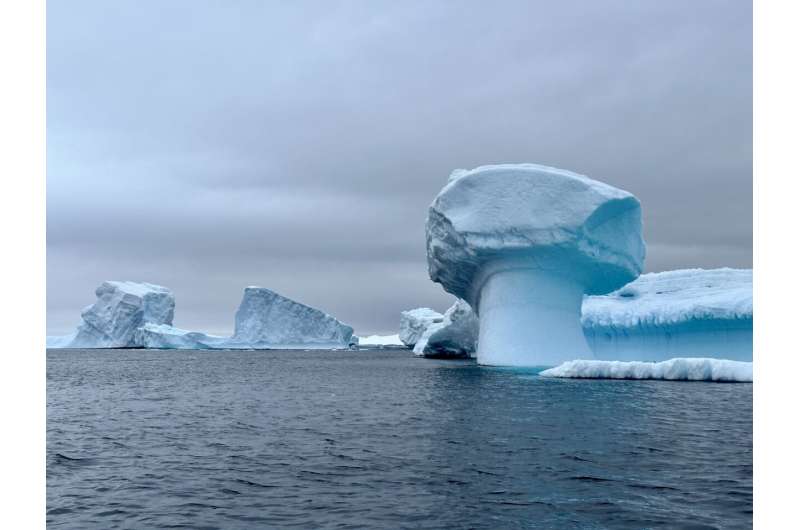This article has been reviewed according to Science X's editorial process and policies. Editors have highlighted the following attributes while ensuring the content's credibility:
fact-checked
trusted source
proofread
Study examines Southern Ocean warming and its climatic impacts

The mid-to-high latitude Southern Ocean (30°S southwards) features prevailing westerly winds, the strongest mean sea-surface winds on Earth, which draw up ocean water from below 2–3 km in a wide circumpolar ring. This circulation system exerts a huge influence on climate under greenhouse warming, because the upwelled water was last in contact with the atmosphere hundreds of years earlier and once brought to the surface, absorbs a vast amount of anthropogenic heat and carbon from the atmosphere.
However, based on the latest climate models, even under the same emission scenario, inter-model differences in simulated amount of heat absorbed by the Southern Ocean are large. "The large spread is a concern, and has huge implications, including for melt of Antarctic Sea ice, ice sheets and ice shelves (center image below), radiative budget of the climate system, hemisphere rainfall distribution, and global sea level rise," says Dr. Cai, first author of the study published in Science Bulletin
Dr. Cai and his team sought to determine what causes the large inter-model differences by synthesizing recent advances, and through examination of available outputs from latest models participating in the Phase 6 of Coupled Model Intercomparison Project. The team surveyed a large body of literature and performed extensive analysis of data from some 30 participating models.
The team found that the large inter-model spread is not simply due to differences in the climate sensitivity, which measures the amount of radiative heating required to raise the Earth surface temperature by 1.0 oC. Previous studies suggest sequestration of heat by the Southern Ocean is mainly through mean circulation that facilitates uptake of additional heating, and that circulation changes because of greenhouse warming play a relatively small role.
The new analysis instead shows that circulation changes contribute to much of the inter-model differences beyond that are attributable to climate sensitivity. For example, under greenhouse warming, the prevailing Southern Ocean westerly intensifies toward the Antarctic, but the wind changes are vastly different across models.
The wind intensification induces changes in the intensity and distribution of upwelling, with serious consequences. An increase in upwelling accelerates melt of Antarctic ice sheets and ice shelves, and the associated meltwater flux into the ocean leads to a more stratified upper ocean, which in turn slows heat and carbon uptake by the Southern Ocean. "There are many such complex interactions at work, some of which are poorly understood and not represented in models, contributing to the large uncertainty," Cai says.
The researchers also found that the uncertainty can arise from a response of remote process to greenhouse warming, such as El Niño, the most consequential climate variability of the Earth climate. An El Niño is known to induce droughts over the western Pacific countries and floods over the eastern Pacific regions. Less known is that El Niño also leads to weakened prevailing Southern Ocean high-latitude westerlies, which over a warming period affecting shelf ocean warming, melt of sea ice, ice shelves and ice sheets.
Surprisingly, inert-model differences in the response of El Niño to greenhouse warming systematically influenced the inter-model differences in Southern Ocean warming. But the changes in El Niño under greenhouse warming itself vastly differs across models. "New perspectives like this add to the growing realization that projecting Southern Ocean warming is one of the most complex issues in climate science," Cai says.
The study suggests that the science of Southern Ocean warming involves appropriately representing interactions of ice shelves and ice sheets with the warming ocean, interactions of changing circulations with carbon cycles that force the circulation changes in the first place, and polar-tropical interactions, to name just a few. Because each of these areas is a challenge, uncertainty likely persists for some time to come. However, identification of such challenges is a start in any effort to move the science forward.
This study is led by Dr. Wenju Cai (Environment, Commonwealth Scientific Industrial Research Organization, Australia) and involves scientists from China, Australia, and United States.
More information: Wenju Cai et al, Southern Ocean warming and its climatic impacts, Science Bulletin (2023). DOI: 10.1016/j.scib.2023.03.049
Provided by Science China Press




















